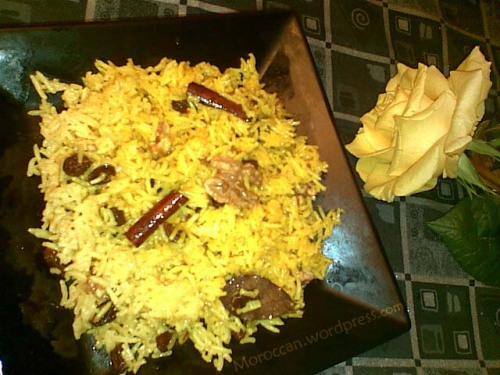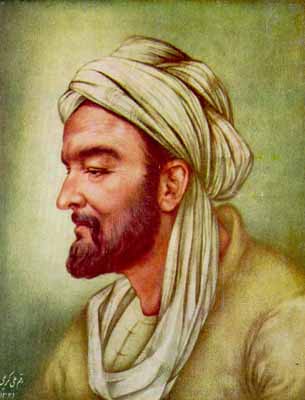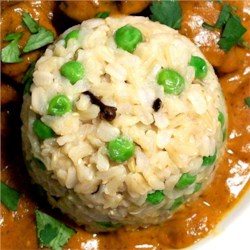 |
| Bengali Sweet Polaoo |
Whenever the craving for fried rice(Chinese Style) used to
bother me, my mother would start cooking the rice, taking the words fried rice
literally. It didn’t taste like the Chinese thing, but it did taste good. In
the marriage receptions or the Saraswati
Puja or on Durgashtami, we used
to have something special. A sweet, colorful, aromatic and savory preparation
of rice. The volunteer servers used to say out loud while rushing past eager
plates, “Polaoo Polaoo Polaoo!!”.
What we Bengalis love to call as homemade fried rice or
“Polaoo” and the people from other parts of India call as “Pulav”, has its
genesis in ancient Persia. In fact, the name of the preparation has remained
phonetically quite unchanged. The Persians called it “Pilav” or “Pilaf”.
 |
| Abu Ali Ibn Sina |
In the tenth century, Abu
Ali Ibn Sina (Avicenna) or
Ibn Sina, recorded various recipes of Pilaf, with advantages and disadvantages
of each of the ingredients. When Alexander the great was served the Great royal
banquet in Bactria, post his conquest of Samarkand, the rice preparation was so
relished by everyone that the soldiers brought it back to Macedonia and spread
it all across the Balkans.
 |
| Babur |
Emperor Shahjahan had dining habits, which had intrigued
Manrique (That story comes in my later blogs); he was not a barbarian, he dined
in the most exquisite of ways. Shahjahan was the fifth Mughal to rule India.
Babur, “The Tiger” was the first one. Babur was a Timurid prince from central
Asian kindom of Fergana in the current Uzbekistan. Babur wished to reestablish
the Timurid line across the region. At the age of 15, he conquered the city of
Samarkand; the place of refinement of Pilaf, a place of sophisticated Islamic
culture, the place known as “The pearl of the Eastern Muslim world”. But Babur
wasn’t able to retain Samarkand for long. Even many years of survival in the
rough mountains didn’t stagger his will. He had his eyes on the capital city of
Afghanistan, Kabul. Eventually he did concur Kabul and by 1526 he had launched
his attack on India. Babur had come from a culture that took great pleasure in
eating. One of the earliest Muslim cookery books described food as the most
consequential of the six senses. After losing Samarkand, Babur had spent much
of his life in the rough mountains, surviving on the hearty meat based diet of
the horse riding nomads of the central Asian steppes.
 |
| Afghani Pilau |
In the 1920s, the local Afridis had invited the British to
watch a display of guns, fireworks and evasive warfare. The British then got an
opportunity to sample the kind of food Babur used to have. There were skewers
of freshly roasted sheep’s flesh which went with the tea and there was, what
they called “Pilau”. Years earlier, a Hungarian scholar who travelled widely in
central Asia in the 1860s had described the method of preparation. The methods of such preparations I am still researching and would publish in a later post. But for now, the Pilau travelled with Babur to India.
When Babur arrived in India, he found the local cuisine utterly disgusting. People used to have boiled vegetables and rice with boiled lentils. The utter lack of meat in the local cuisine was of great dislike for Babur. Babur thus brought in his persian cooks to cook for him. Pilau became a part of the royal cuisine, which slowly trickled out of the king's kitchen to the common man of northern india. India being the land of much finer and fragrant rice, further enhanced the recipe and transformed it to Pulav.
Over the centuries Pulav used ghee instead of animal fat, vegetables instead of meat and basmati instead of some other rice. Safron and turmeric were used to color the rice and local spices were added according to the regional tastes. The humble Pulav was made India's own and became the favorite of the elite brahmins and the Maharajas.
 |
| Peas Pulav |
Centuries later, when we wish to have the Peas Pulav in Mumbai, it tastes starkly different from the Polaoo of Bengal; each bearing its special set of ingredients; each bearing a special meaning to the people who belong there; each associated with the varied traditions of the places. Pulav isn't an independent dish anymore it is eaten with various other sides. The fragrant colored rice, has travelled a long way on the back of horses; through numerous bloodbaths and has metamorphosed into the present day vegetarian special rice which is so entwined into the Indian tradition that some festivals are incomplete without it.
Apologies to the readers for not adding any recipe to this post. All the fine recipes of Pilaf/Pilav/Pilau/Pulav/Polaoo comes in the next post.







This is so fascinating....I really am amazed by the amt of research put into it. This is unique too in terms of content! I have never seen any foodblogger bothering to dig out so much info about the history of food. All are happy with just recipes!!
ReplyDeleteThanks! There's lot more in the bag, but can't take all out at once; that's bad blogging.. :D And I feel tracing food history is the best way of tracing the movement and metamorphosis of the species. Thanks again! More stuff coming up soon.
DeleteI was just thinking of posting the sweet pulao in a couple of days:)
ReplyDeleteYes yes please. I follow your blog, who know I may find something new to research on. :)
DeleteVery informative.
ReplyDeleteThanks Rajesh!
DeleteWell a very interesting glimpse of medieval history through the pulao/pilaf/pilao perspective... really enjoyed the post ...
ReplyDeletehttp://pradyumna-ray.blogspot.com/2013/01/they-are-all-same.html This one is the continuation..
DeleteThanks for reading! :)